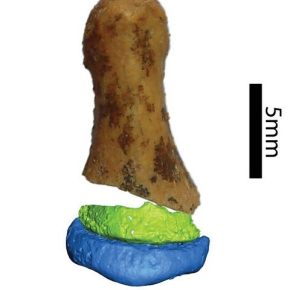
Newfound phalanx fragment shows Denisovans closer to modern humans than Neanderthals
The genomic sequencing of exceptionally well preserved DNA in a phalangeal fragment from Denisova Cave (Siberia) in 2010 revealed it belonged to the member of a previously unknown human population, the Denisovans, who were closely related to the Neanderthals1
. However, because few Denisovan bones have been found, the morphology of these hominins remains uncertain. Now a team of scientists from the Institut Jacques Monod (CNRS / Université de Paris) has measured and photographed another fragment found in Denisova Cave. Genomic analysis reveals it is the missing piece of the same phalanx whose proximal fragment enabled initial sequencing of the Denisovan genome. Together with colleagues from the PACEA laboratory (CNRS / University of Bordeaux / French Ministry of Culture) and the University of Toronto (Canada), the scientists compared the new fragment to the phalanges of Neanderthals and anatomically modern humans. Their analysis indicates it is very close to the latter, and less like the former. Yet this structural similarity does not extend to the molars and mandible found on the Tibetan plateau2
, which feature more archaic characteristics. The researchers are intrigued by the Denisovan morphological mosaic and are seeking new skeletal remains to better characterise this “third” human group. Their findings are published in Science Advances (4 September 2019).

- 1J. Krause et al., The complete mitochondrial DNA genome of an unknown hominin from southern Siberia. Nature 464, 894-897 (2010). D. Reich et al., Genetic history of an archaic hominin group from Denisova Cave in Siberia. Nature 468, 1053-1060 (2010). M. Meyer et al., A high-coverage genome sequence from an archaic Denisovan individual. Science 338, 222-226 (2012).
- 2D. Reich et al., Genetic history of an archaic hominin group from Denisova Cave in Siberia. Nature 468, 1053-1060 (2010). V. Slon et al., The genome of the offspring of a Neanderthal mother and a Denisovan father. Nature 561, 113-116 (2018). S. Sawyer et al., Nuclear and mitochondrial DNA sequences from two Denisovan individuals. Proceedings of the National Academy of Sciences of the United States of America 112, 15696-15700 (2015). F. Chen et al., A late Middle Pleistocene Denisovan mandible from the Tibetan Plateau. Nature, (2019).
Morphology of the Denisovan phalanx closer to modern humans than to Neandertals. E. Andrew Bennett, Isabelle Crevecoeur, Bence Viola, Anatoly P. Derevianko, Michael V. Shunkov, Thierry Grange, Bruno Maureille, and Eva-Maria Geigl. Science Advances, September 4 2019. DOI: 10.1126/sciadv.aaw3950


